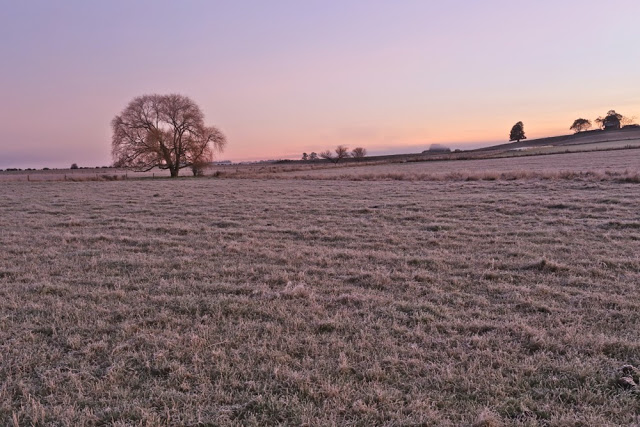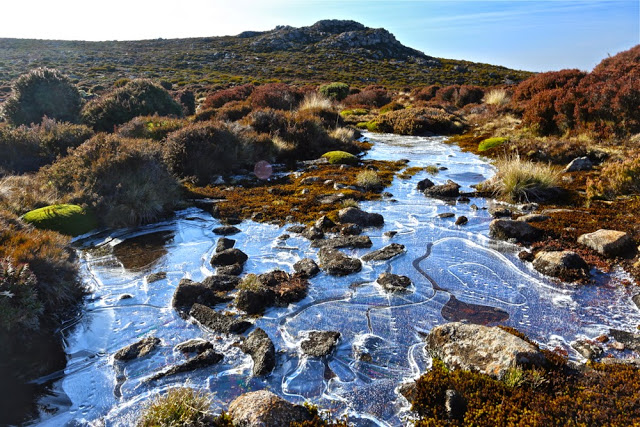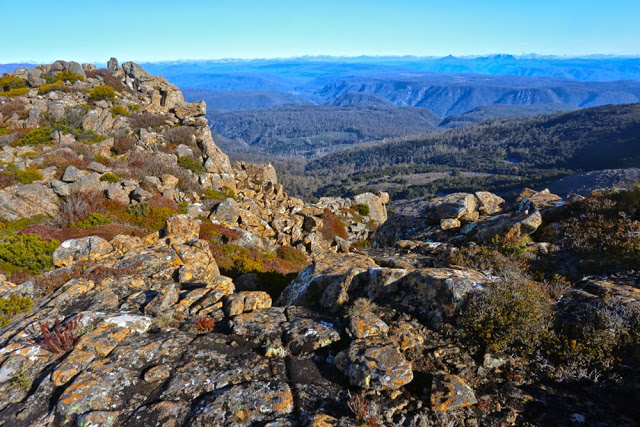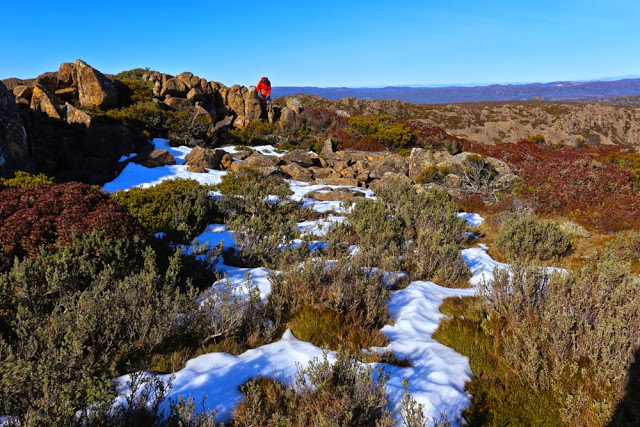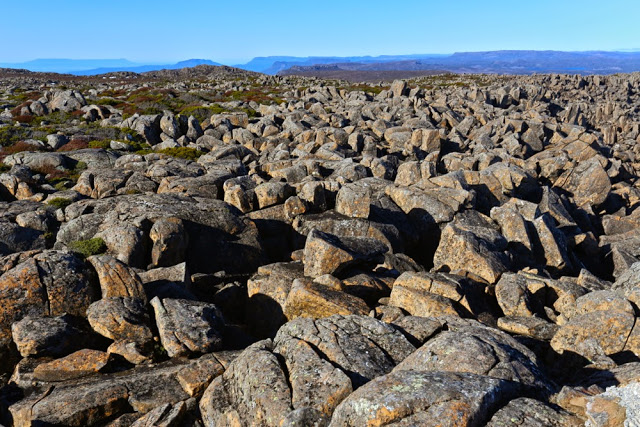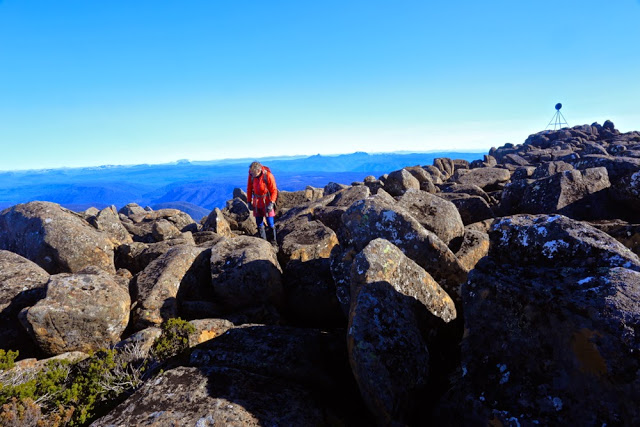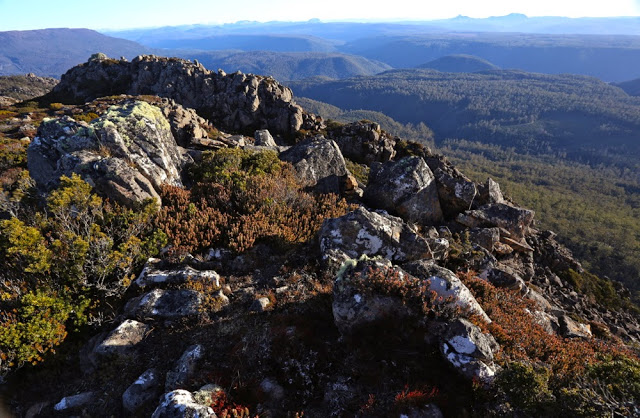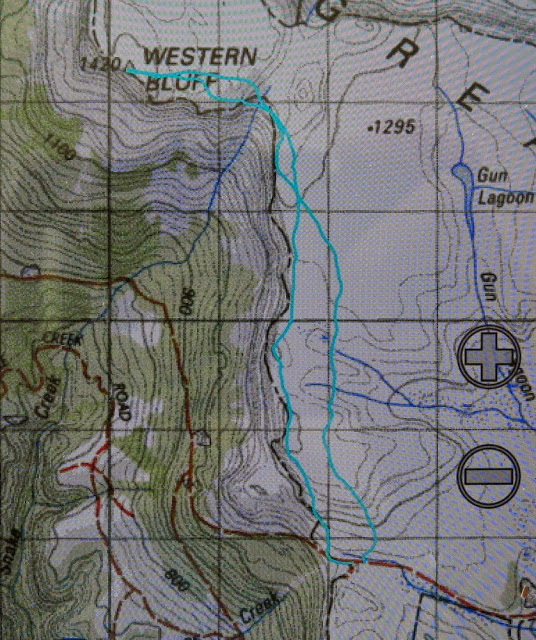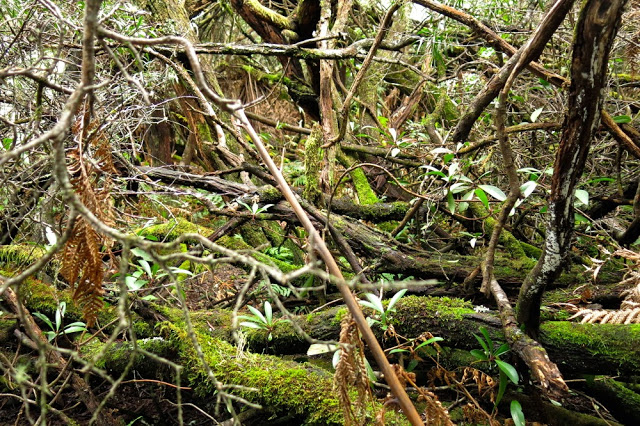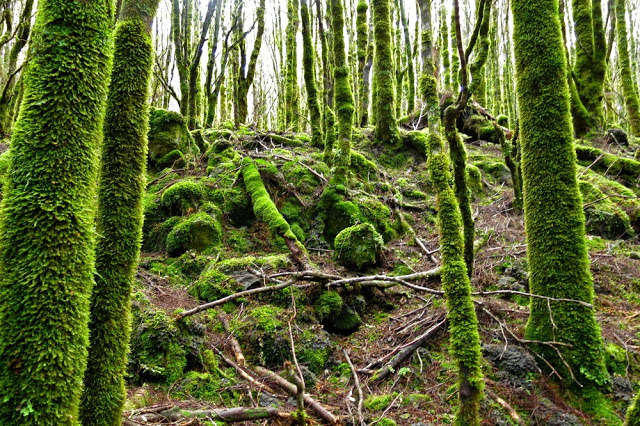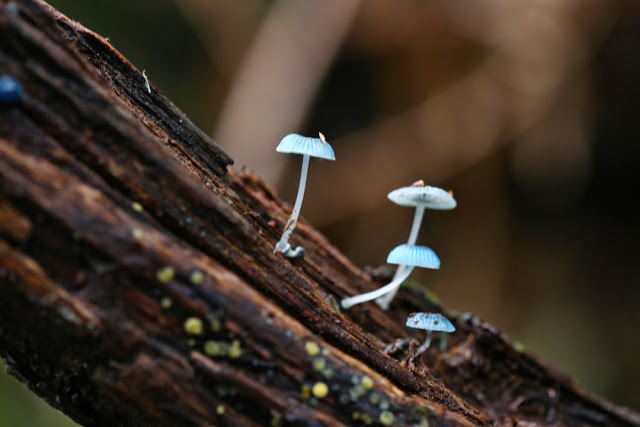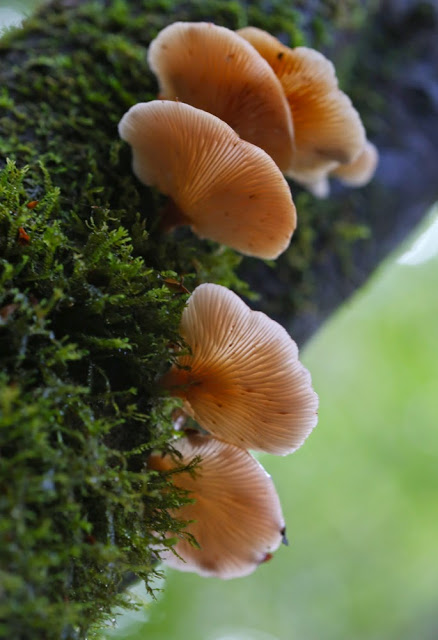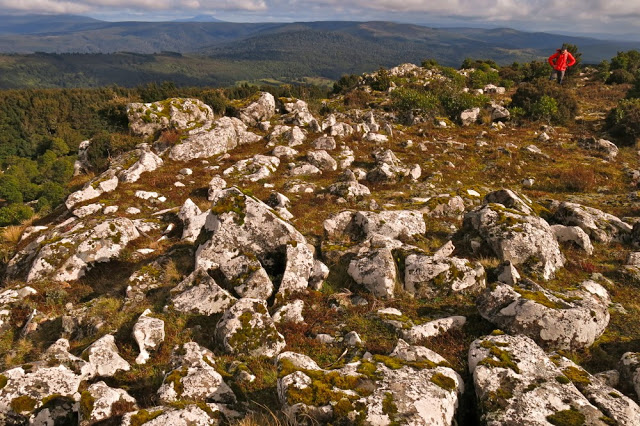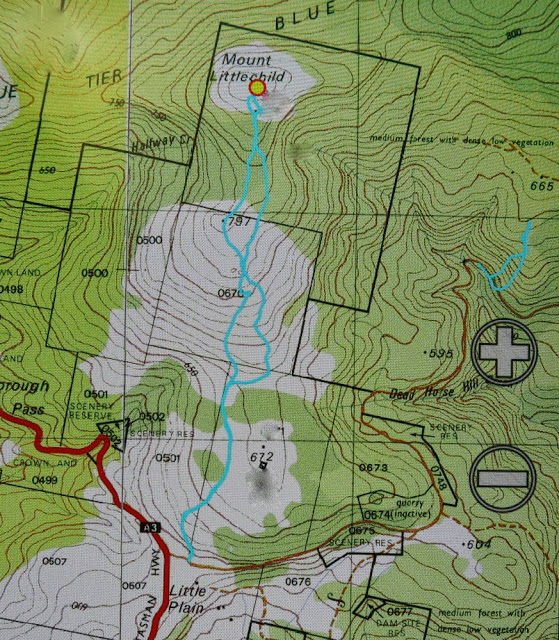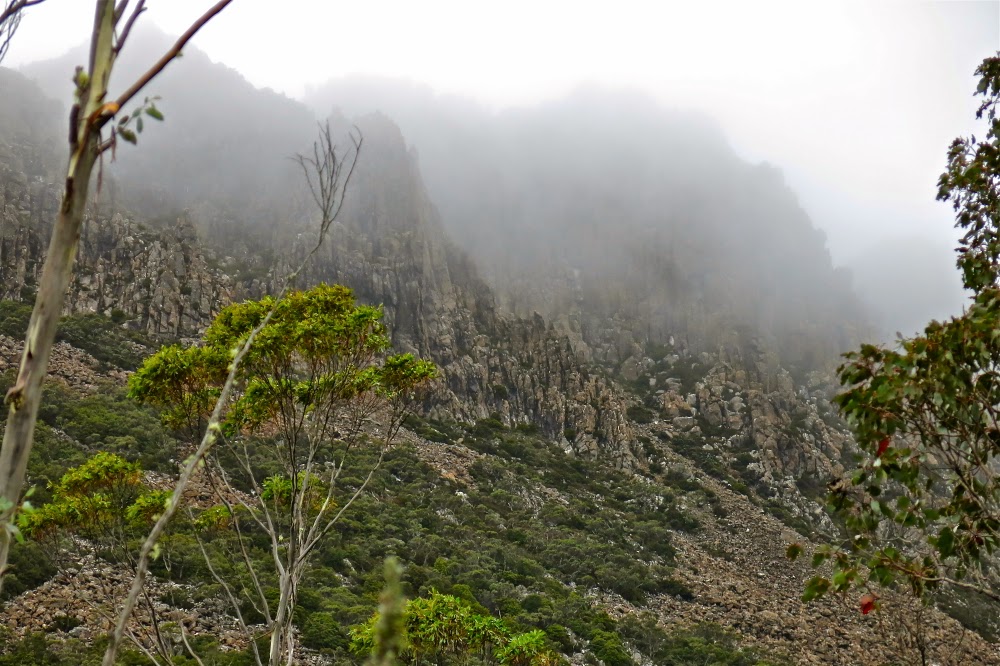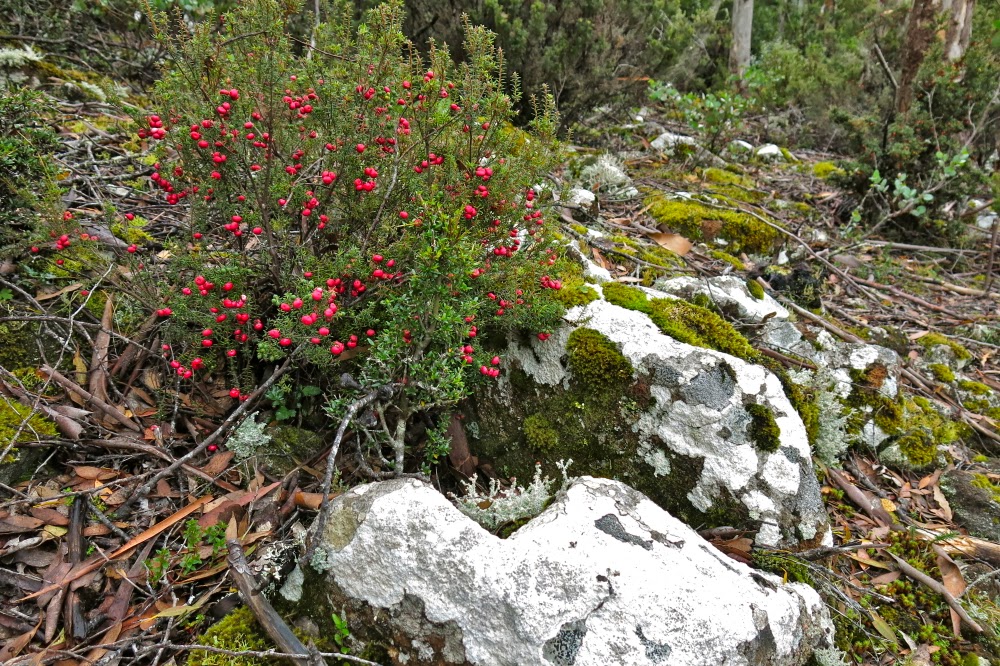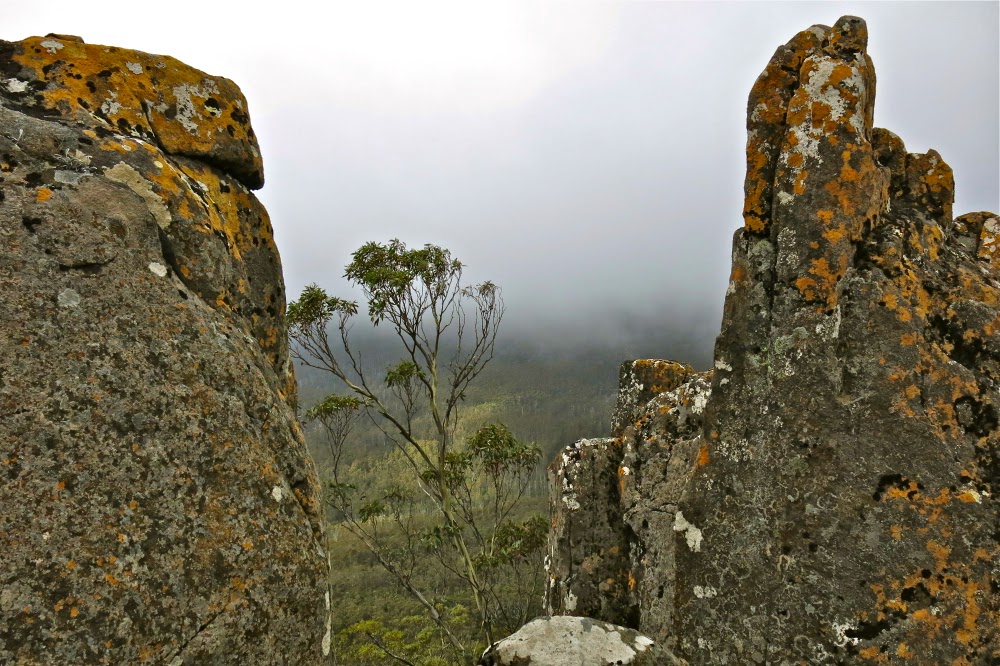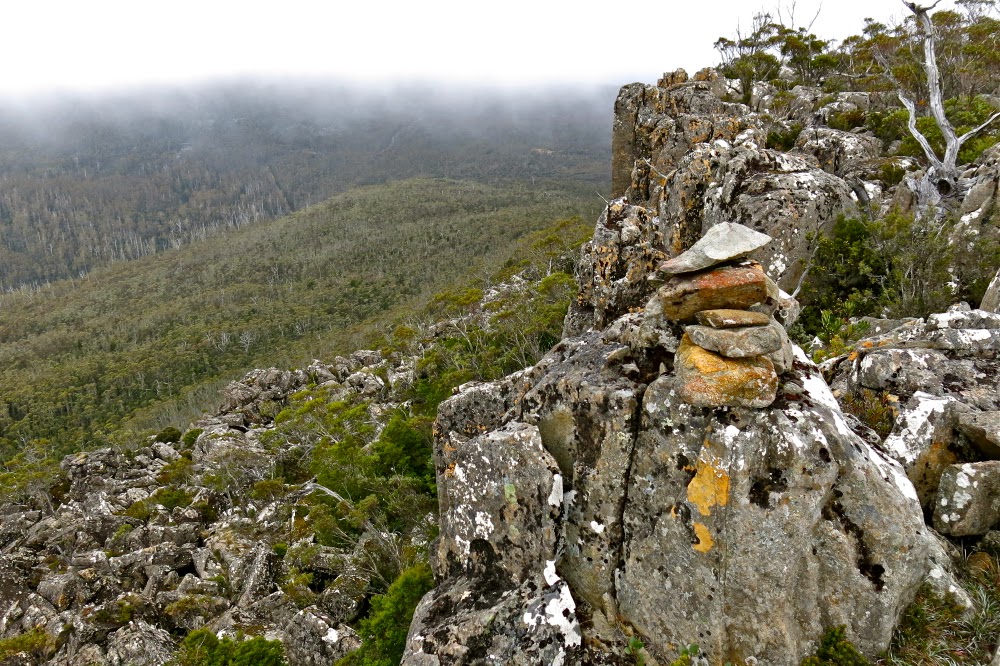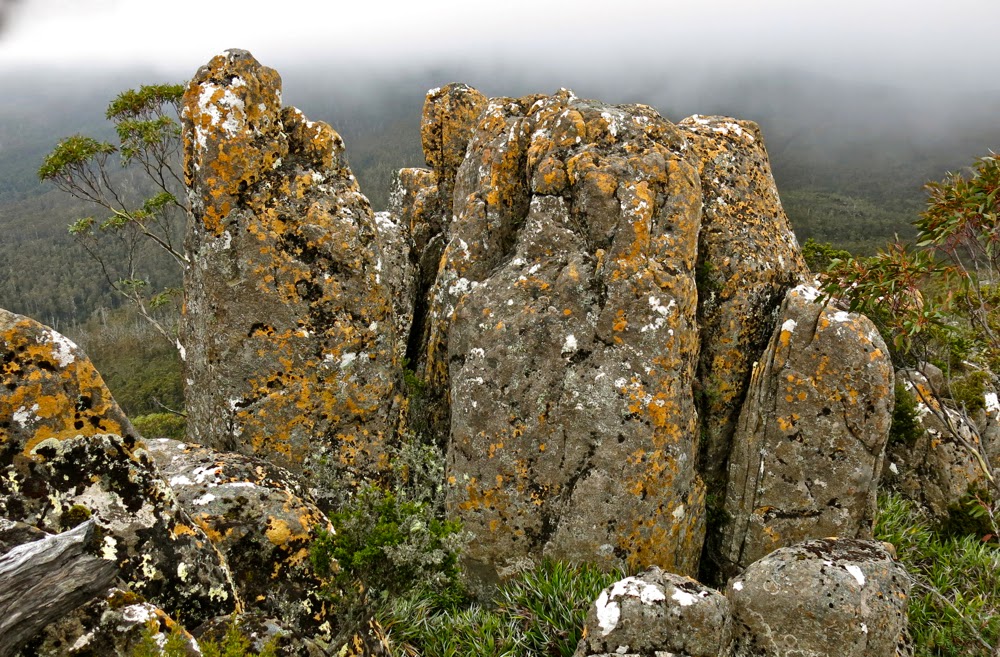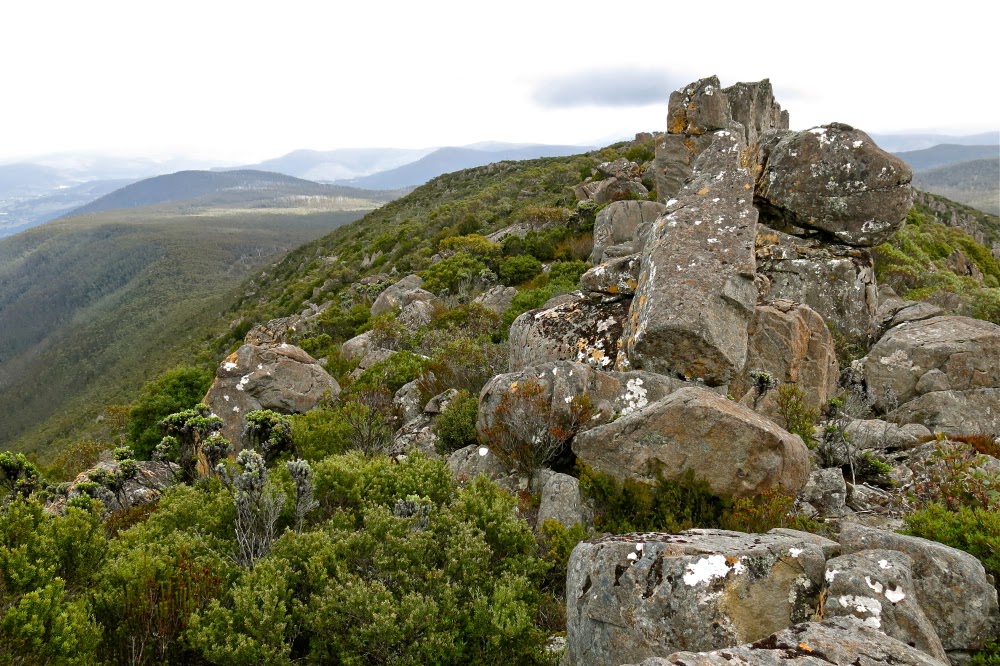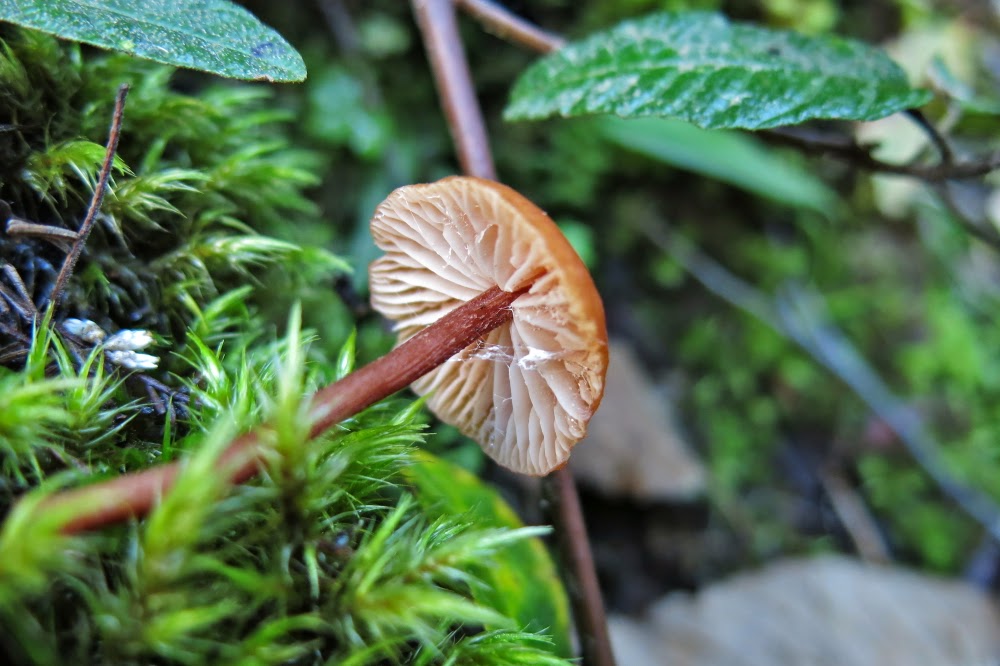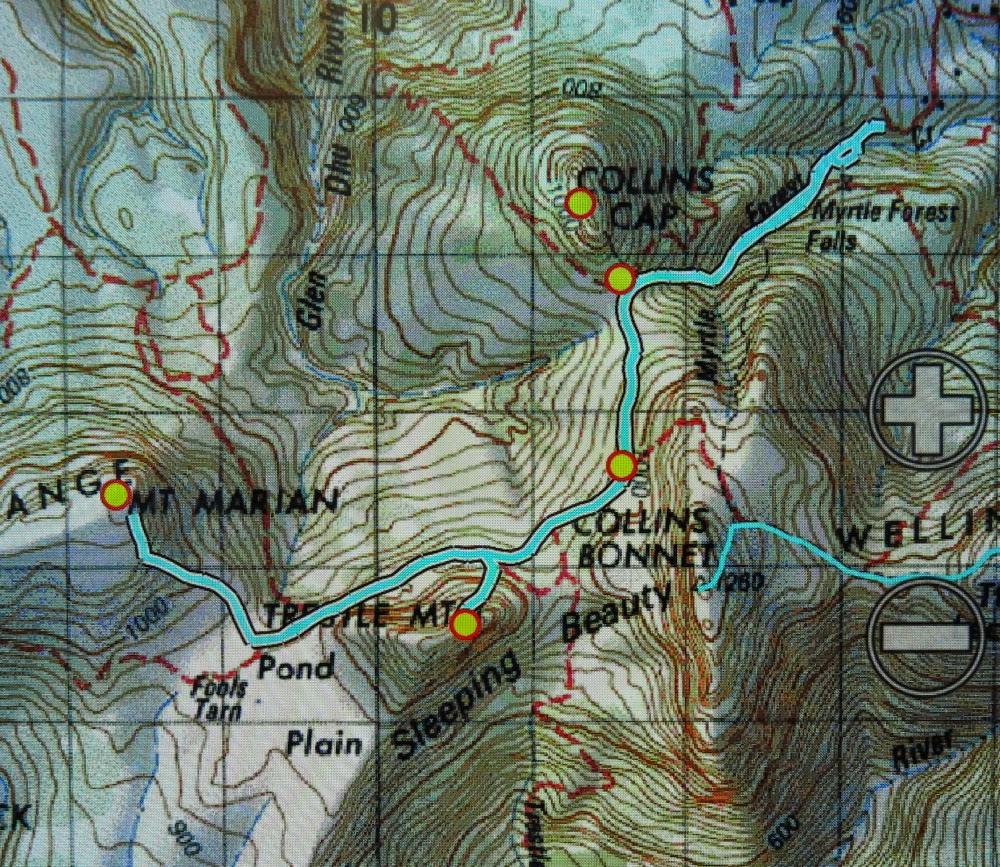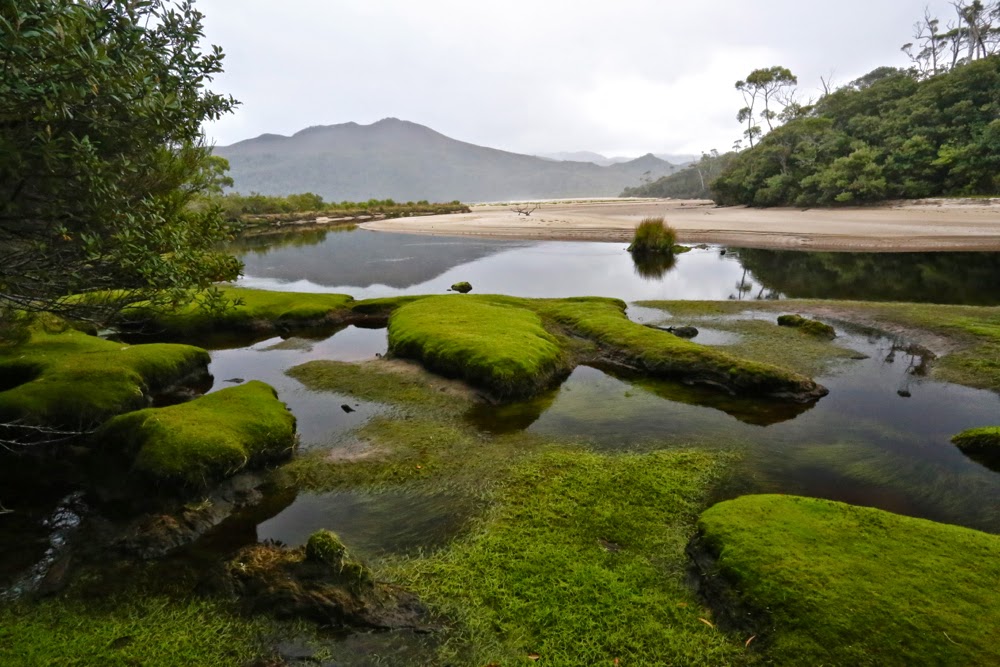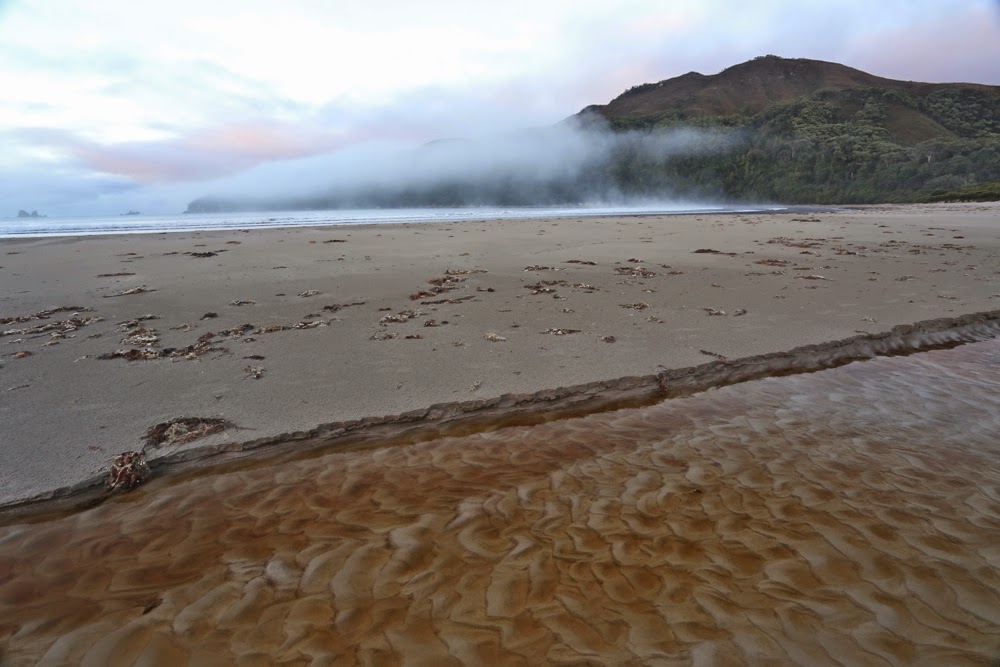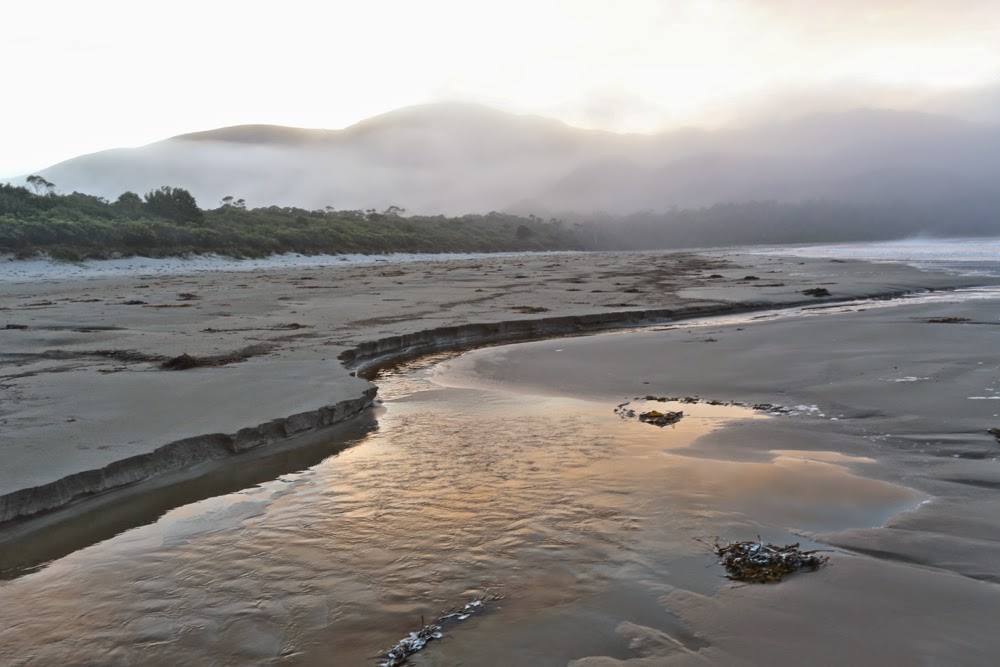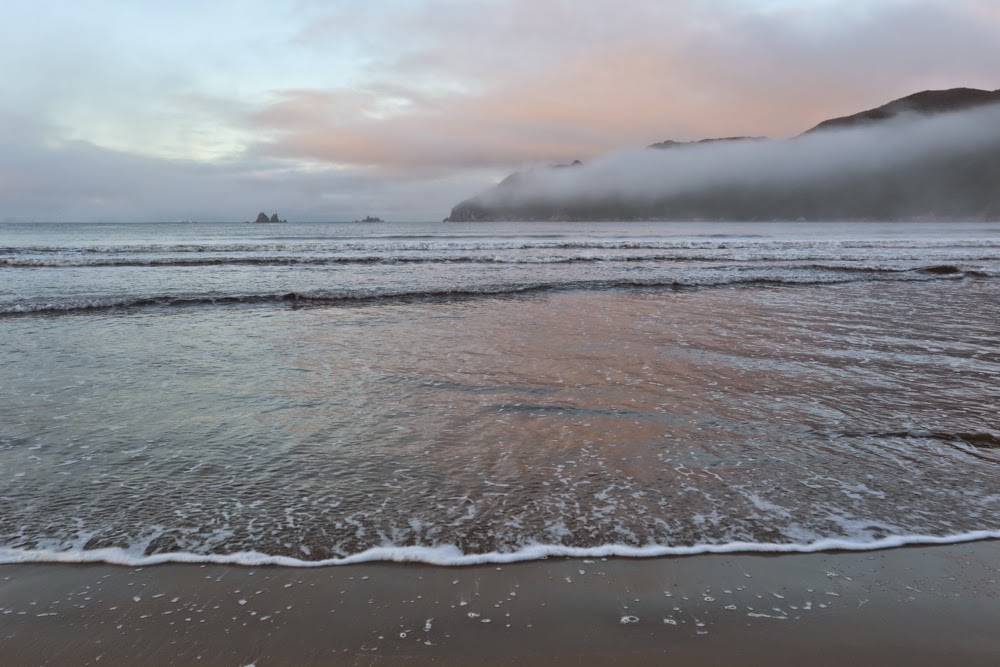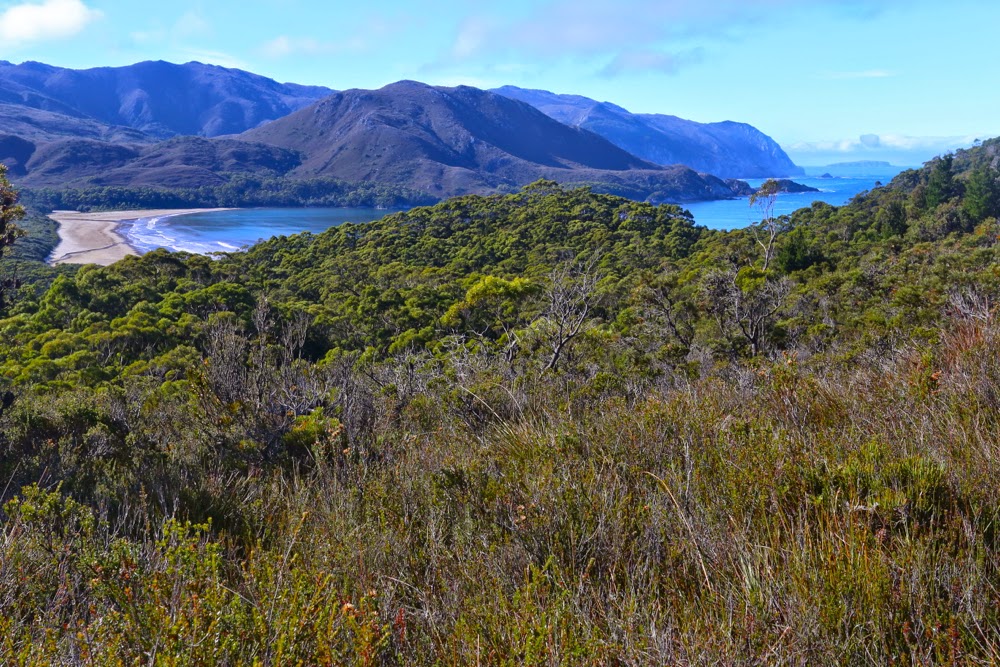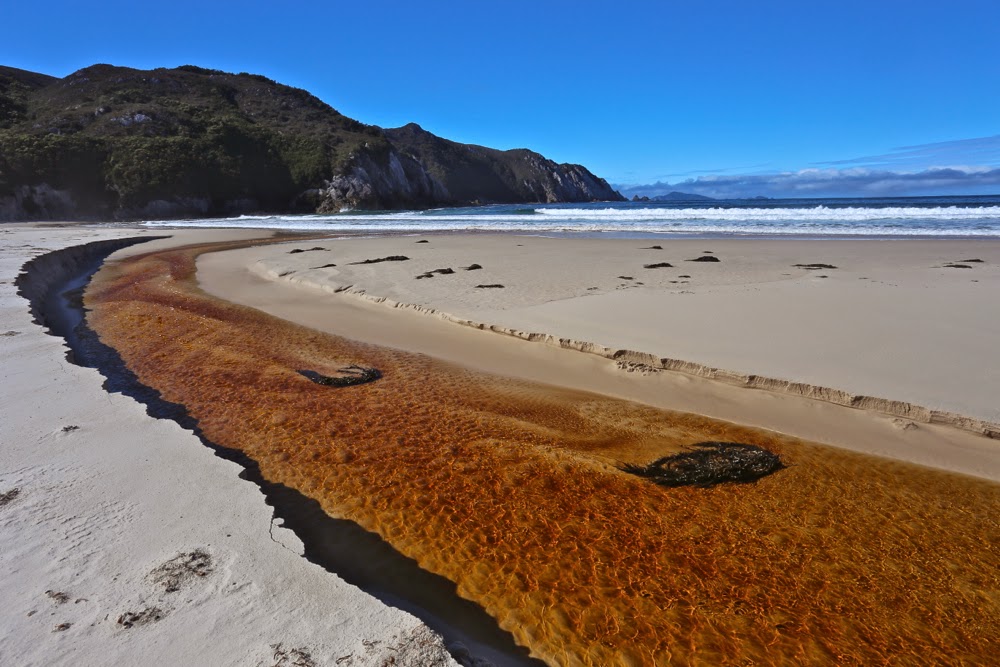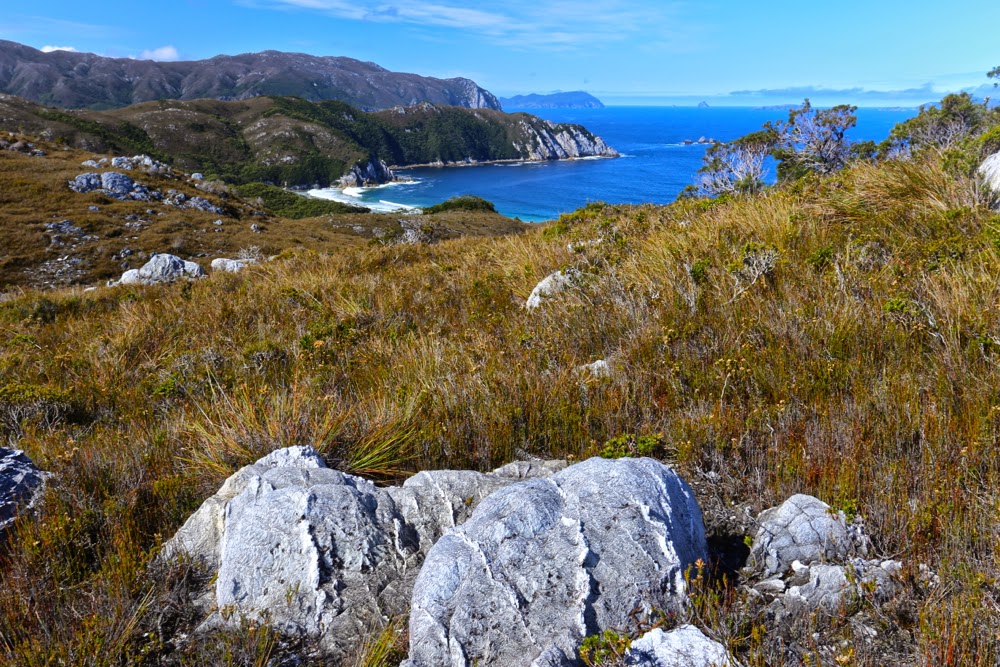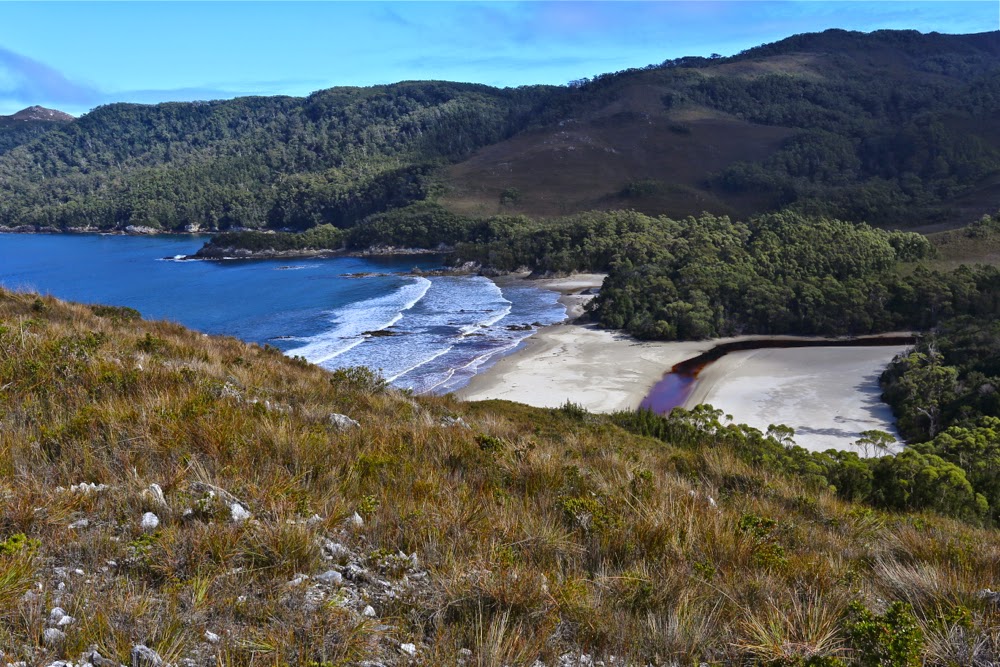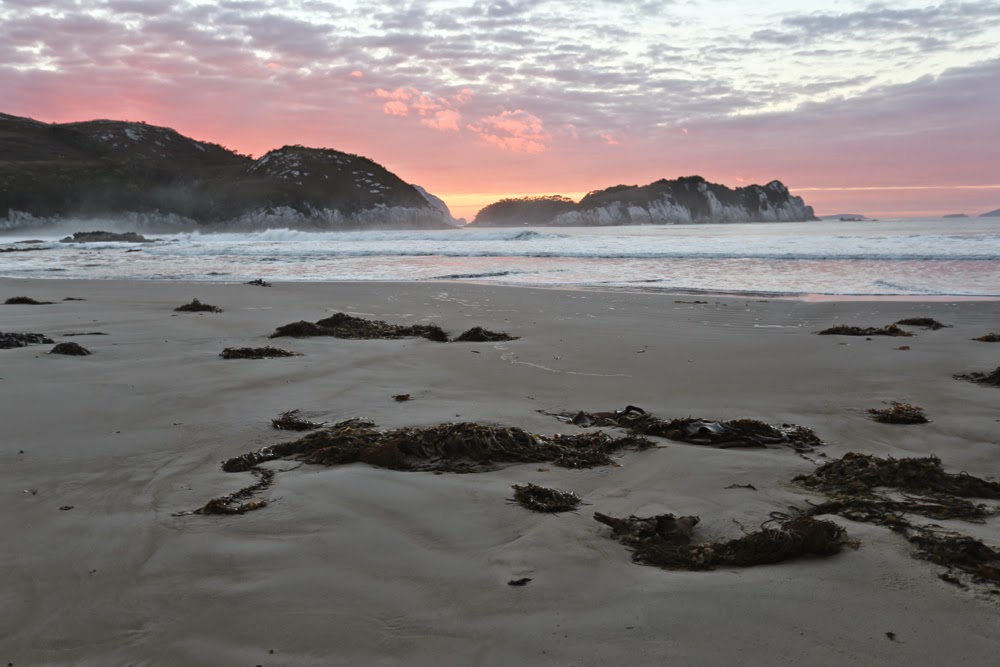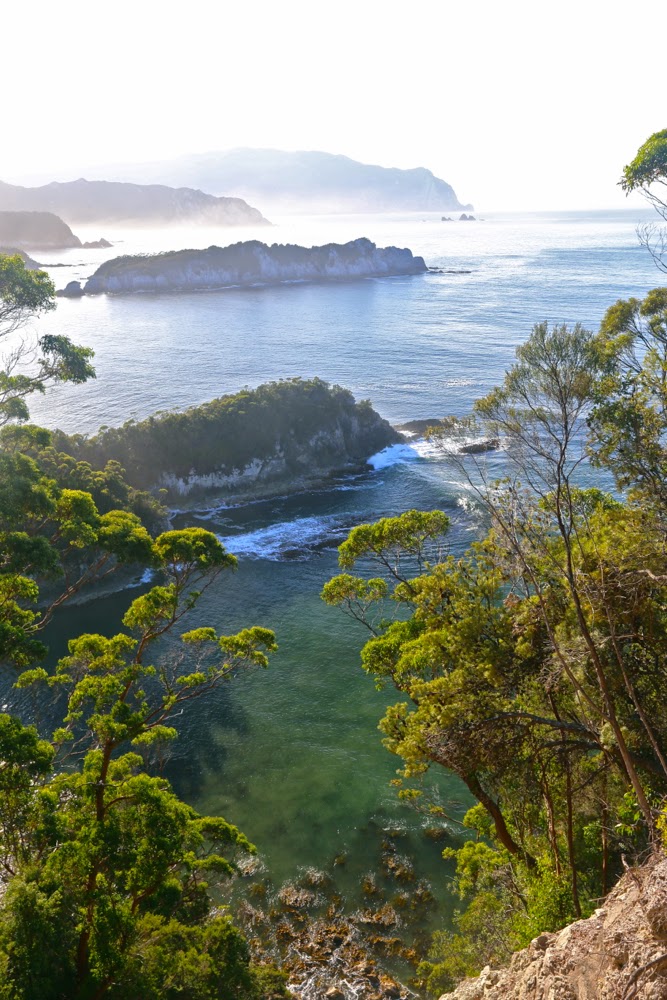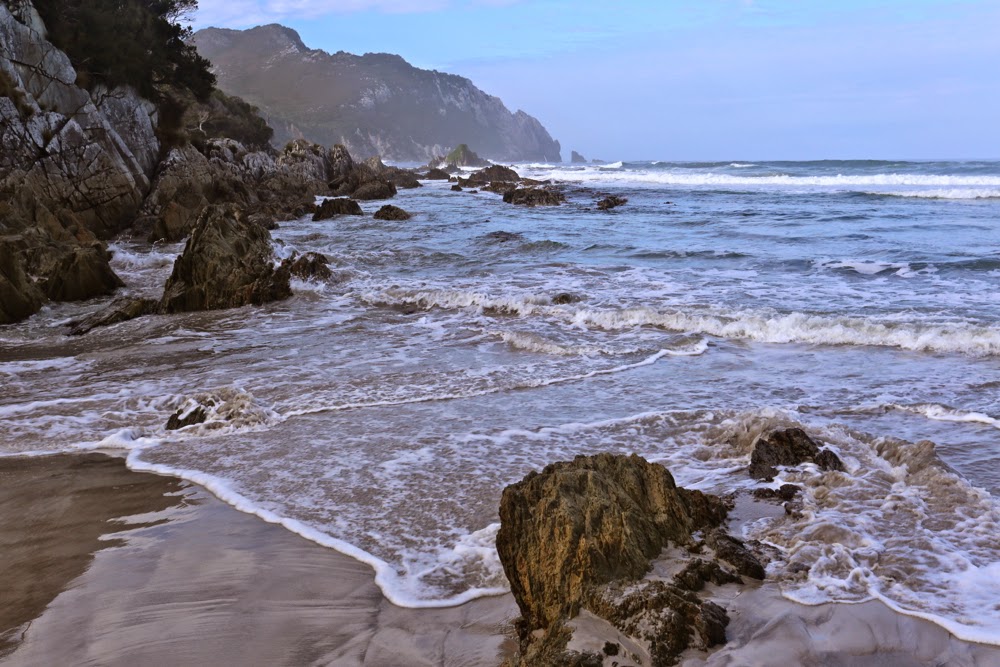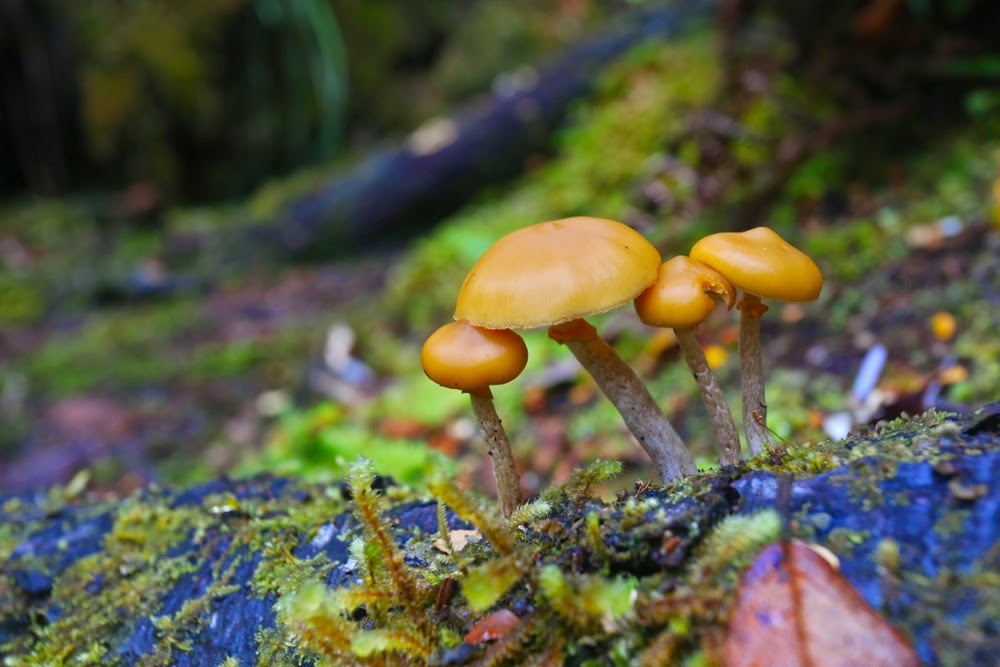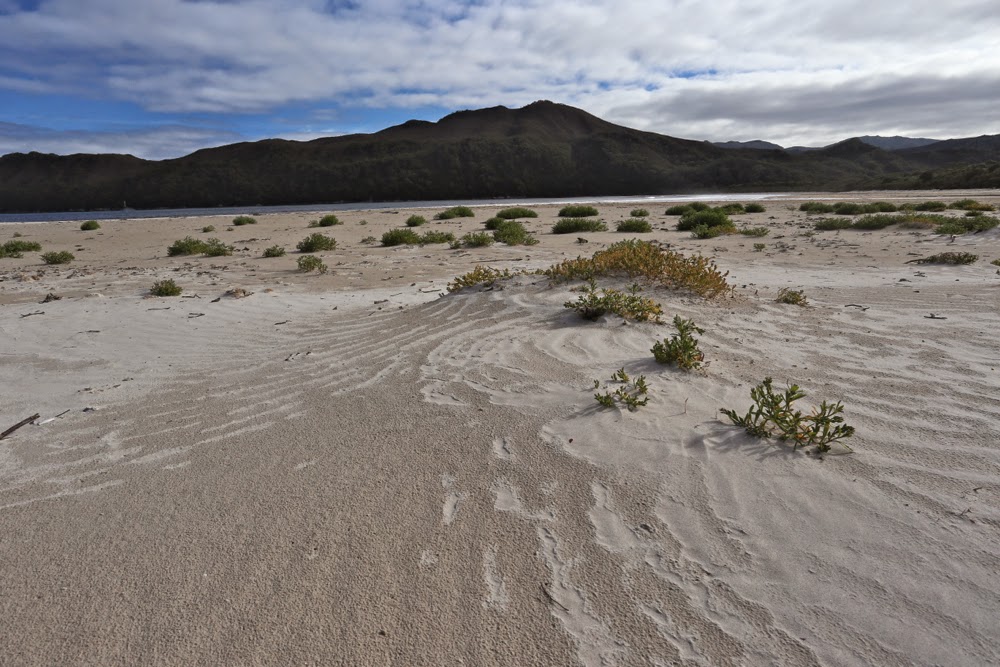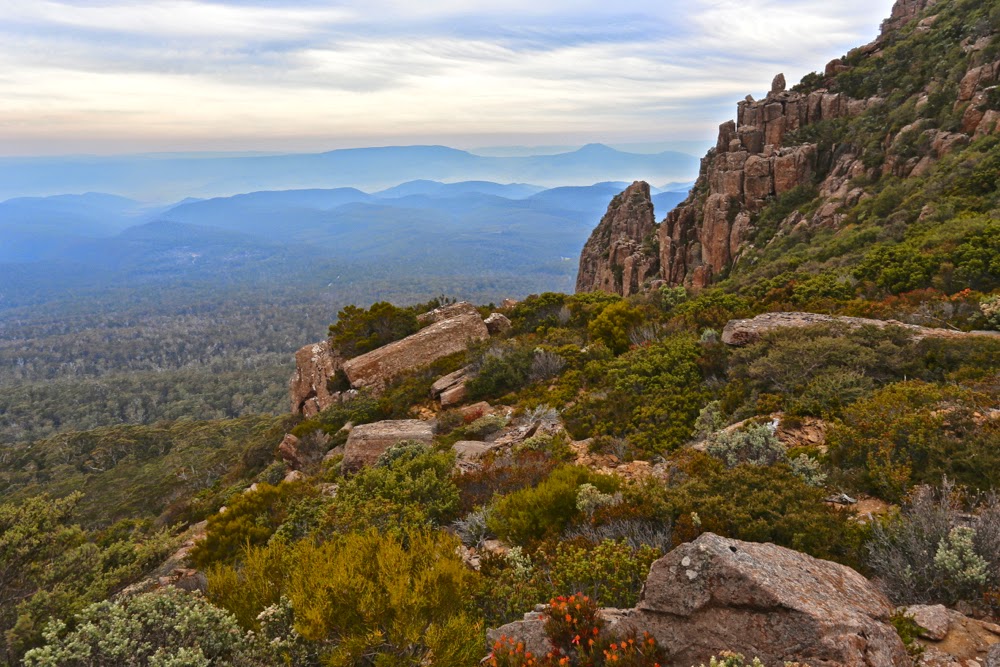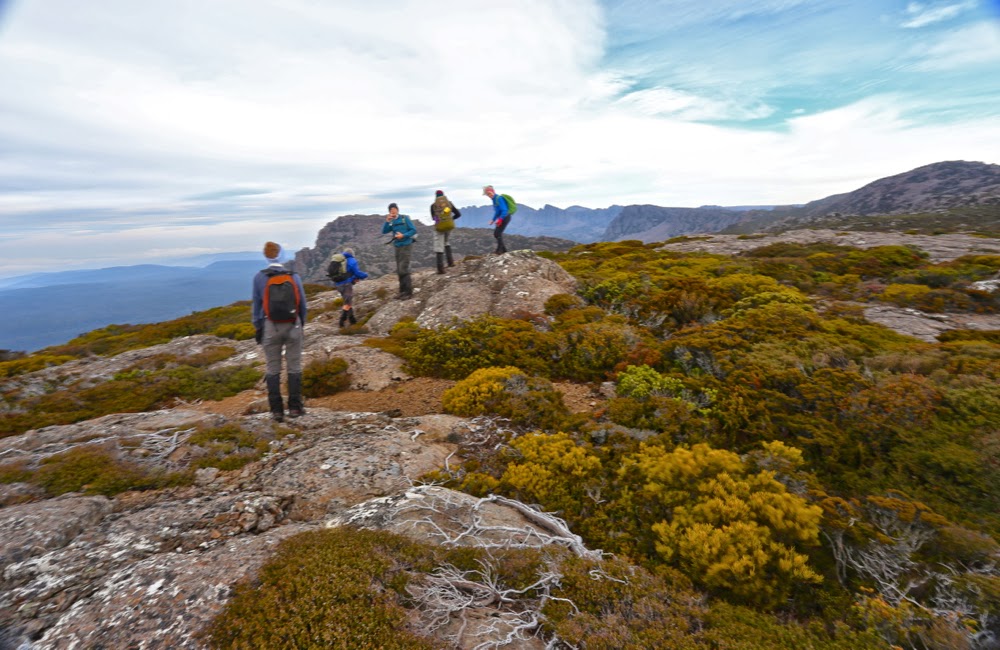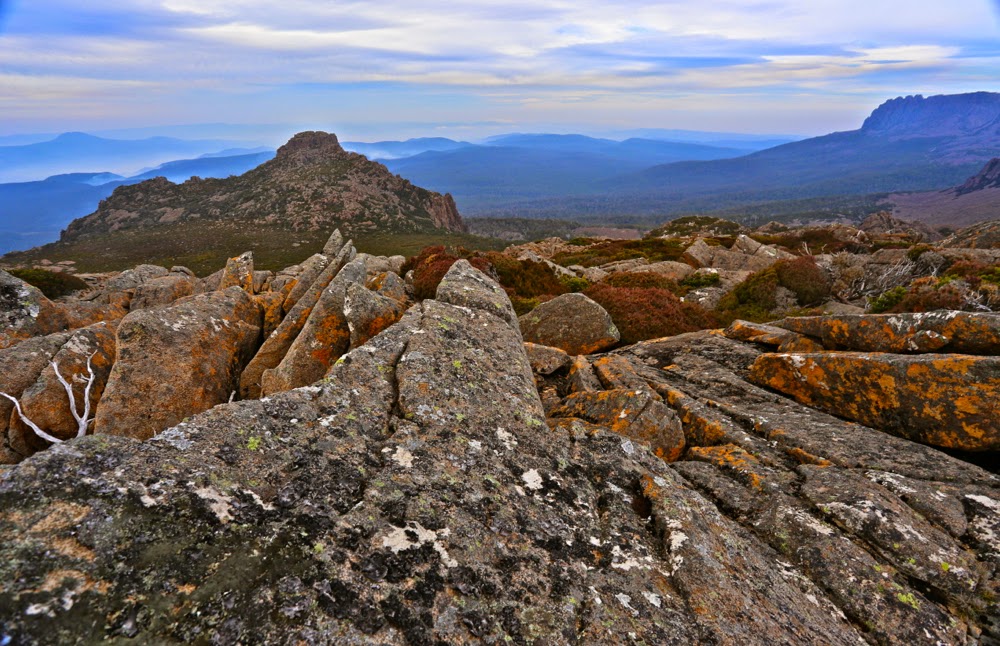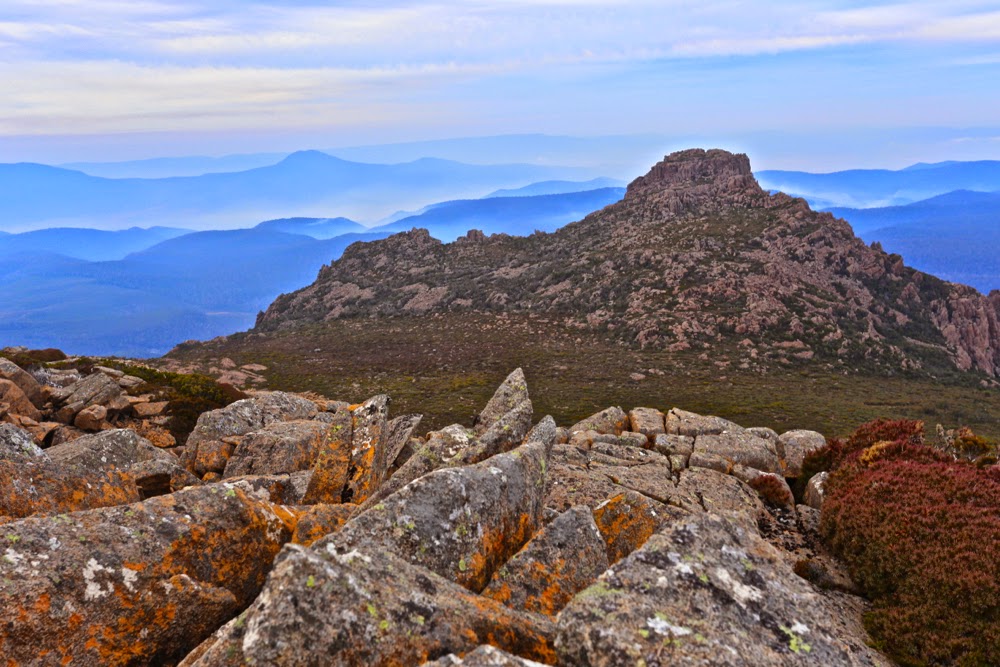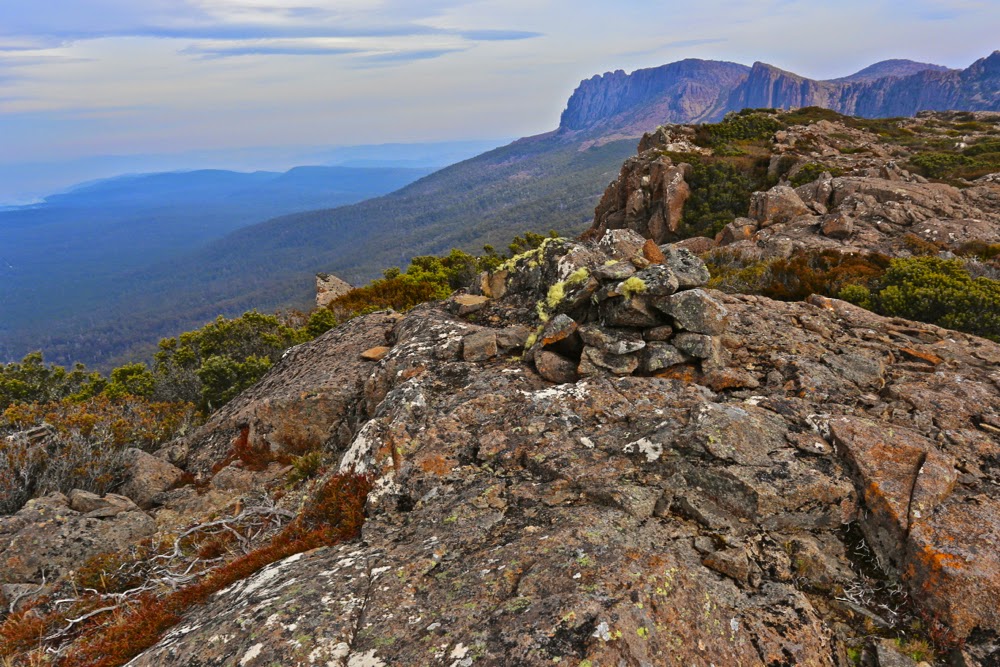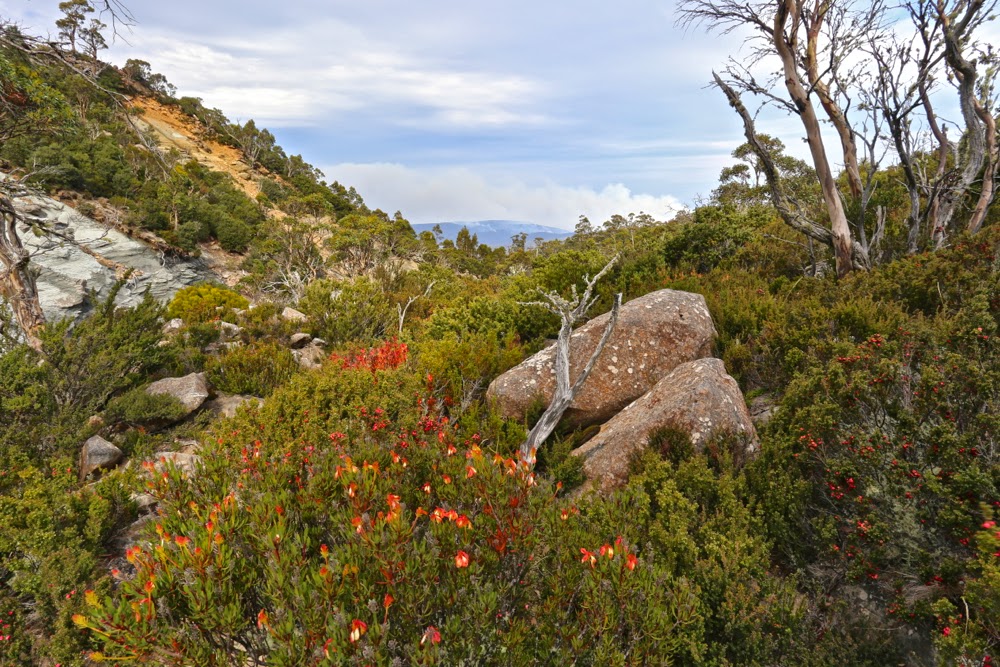South West Cape Track.
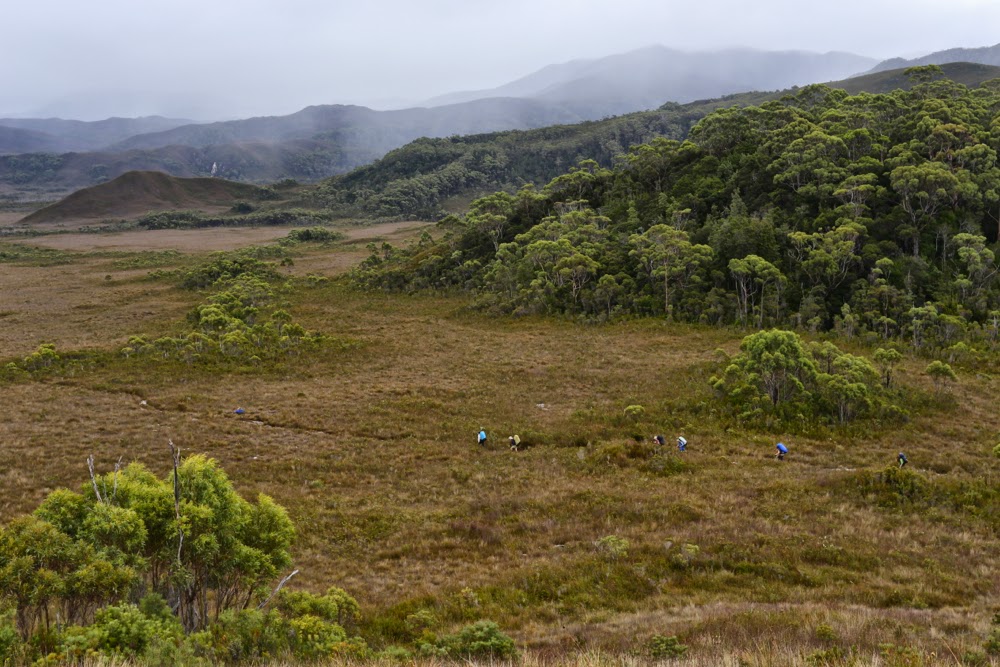
South West Cape Track: hard or easy? It depends on your expectations as created by your experience and the context within which the word is used. Pictured are the others walking along the path that most found easy. I added challenge by climbing little thises and thats along the way. Warning: the blog this week is not easy :-).
The entrance to New Harbour
Dawn on Day 2, New Harbour.
Same, looking in the other direction (east)
Looking mostly south. This is also the view out my tent on the final evening / morning
I stood on the summit of New Harbour Range, mesmerised by the view, my spirit reaching out towards Antarctica to the south, South America to the West, New Zealand to the east. Infinite space; infinite glory; infinite peace. My being was no longer coterminous with my epidermal layer but transcended to a space beyond, which could not be numbered. One of the three companions who had climbed with me turned to me and said, most aptly: “You know, I’m not a religious person, Louise, but this here is the nearest I get to a religious experience.”
Day 2. Rising above New Harbour (en route to Hidden Bay, then Ketchem Bay), and looking back to Smoke Signal Hill and the New Harbour Range behind. Both of these would be climbed by four of us on our return leg.
He is, of course, so right, but his words had a bitter sting in our current political context, as we bushwalkers are, basically, fighting for our right to have experiences like this in this area we called wilderness, to keep these areas accessible yet untarnished by the sound of jet skis, the sight of grand luxury tourist hotels and cable cars. Liberal governments, both state and federal, make the assumption that spiritual connection to the land – a transcendental experience that is prompted by place – is something that only indigenous people can experience, and that if a non-indigenous person has what might be called a soul, then they should go off to a dark and musty church building made by human hands in order to connect with the eternal. I am sure there must be somewhere bushwalkers who are only there because it’s “sport” and a challenge to be had in nature, but the ones I mix with are there in the wild places because it is precisely in such infinite beauty that we find freedom and peace, and that these are things we need to keep happy and sane.
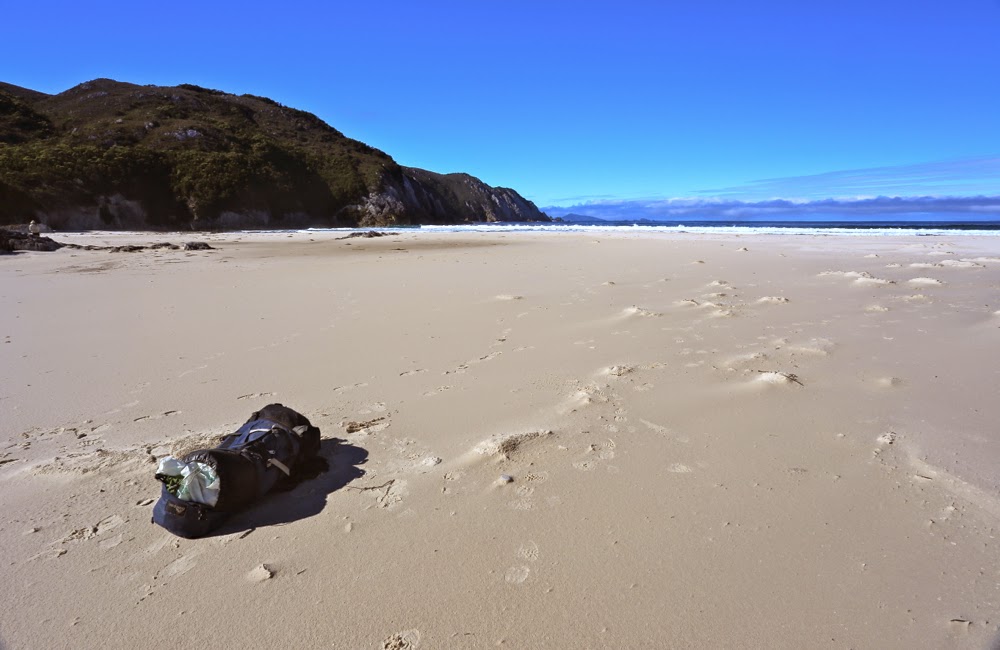
A pack. A wild beach. Does it get any better than that? (Hidden Bay).
Further along Hidden Bay, where we had an early lunch having inspected the elephant seal that we hoped was just exhausted but that we feared was dead.
But let me begin at the beginning, which I guess is when I read “Mt Karamu” on the Hobart Walking Club trip list, checked out the coordinates of this peak, and signed up with record-breaking speed, hoping I hadn’t delayed too long to be given a place. And several months later, there we stood on the
Denny King airstrip at Melaleuca, ready to venture into this part of the state that I have long coveted but never had the opportunity to explore.
Same Day. Now we’re above Hidden Bay and about to get our first glimpse of Ketchem.
First sighting of the fabulous Ketchem Bay with its rocky islands and caves, nooks and crannies: our camping spot for the night.
What does the word “wilderness” mean to you, I wonder. To me, it suggests vastness, ruggedness, remoteness, and ruthless nature with no attempt to be tamed by audacious and pretentious humans. If this exposure to the unleashed forces of nature in all its sublimity is what you desire, then the ne plus ultra in a Tasmanian context must surely be the South West Cape of Tasmania. Even the flight in to utterly isolated Melaleuca, perilously near to rocky faces that can kill you with a single kiss, fills you with a frisson of delight.
Ketchem Island from Ketchem Bay. Dawn breaks on Day 3.
As I reclined in my tent on the final evening, gazing out past rainforest trees at the endless variety of the patterns of force as the waves crashed on the sand about 120 metres from my bed, I thought about our governments and their concept of luxury, for to me there is no greater luxury than the liberty to have this sight. I let my eyes wander in the direction of Antarctica to the south, a place that I could not see, but just knowing that it was the next expanse of land was enough to thrill – like reading on a menu the process of marination and the herbs and spices that have gone into the dish you’re about to eat. The very knowledge adds flavour that you would not otherwise experience.
Day 3. So far, we are avoiding the shepherds’ warning of the dawn and are enjoying glorious weather for our climb to Mt Karamu. Here we are looking back east as we head for Wilsons Bight.
Now this bit was NOT easy. See those rocks there lining the headland to the left? They were the scene for one of the best games of my life: an adult version of musical chairs + What’s the time Mr Wolf? Dinner time, or the moment the music stopped, was the time the next huge wave approached. On cue, you had to rush post haste to the nearest rocky island, usually about 1 metre high and 1.5 long. Perched up there you waited, usually 7 waves long, for the next opportunity to advance a square. If you missed, you got drenched and risked being taken places you didn’t want to go to by the force of the incoming tide. I was pleased to emerge at the end as dry as a bone, but not all my friends had the same happy fate.
I thought about how simple our needs become in the wilderness. Do you want to know what I thought of as other luxuries? Not a glass of champagne on a pontoon with fake palm trees and facile conversation with others whose world revolves around money. No. Here is my list of “negative luxuries” if you will: dry boots at the end of a day; packing up the tent without rain falling on you; putting your hand out the tent flap without having leeches jumping onto it; feeling free to use toilet paper rather than leaves (a self-inflicted hardship I employ to help protect the environment); food that has not been dehydrated; fresh undies each day. “That sounds horrid”, do I hear you say? These little pleasures are so often taken for granted yet they also indicate tiny hardships we take on board for the greater luxury of being there in the midst of such unattenuated beauty, and the beauty is so overwhelming that we just laugh together at what we go through to be there.
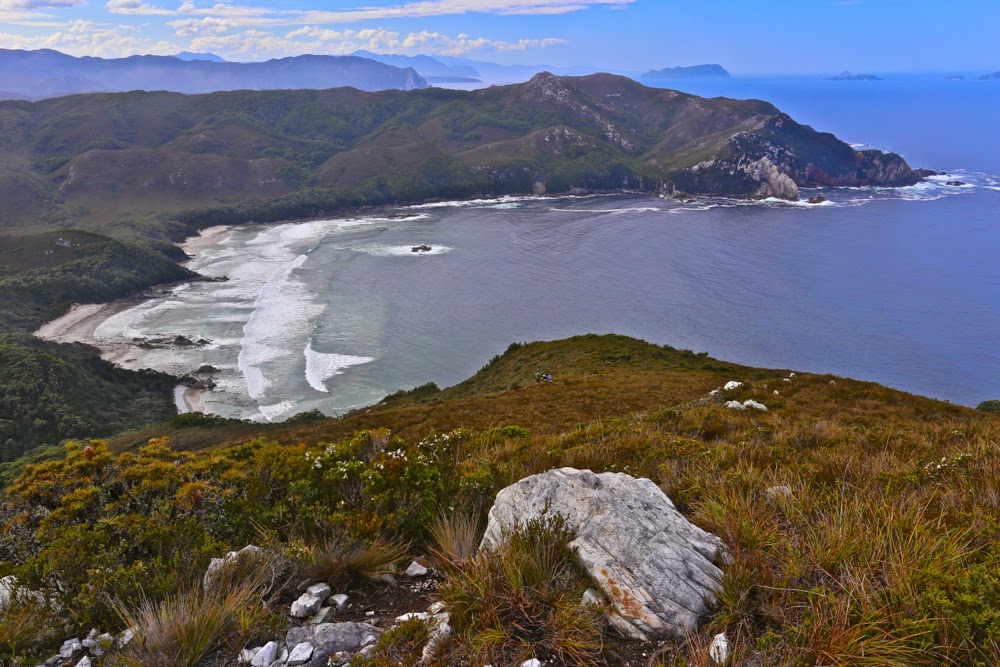
Wilsons Bight far below now. This shot is taken not far in vertical metres from the summit, although in horizontal metres there was still quite a bit of ground to cover, as Karamu has a long ridge leading to its highest point, which is right at its northern tip. Plenty of time to enjoy expansive views to left and right, and to gaze down on SW Cape – obviously, with a name like that, the furthest point to the south west of our island state.
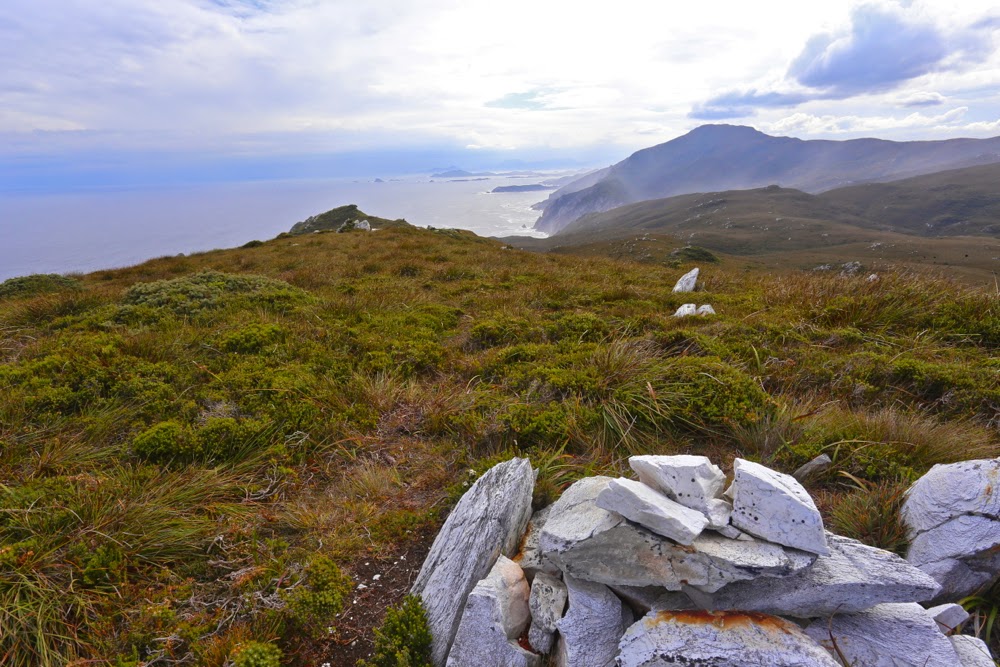
The view to the north from the summit of Karamu
Much as I adore wilderness and was looking forward with eager anticipation to this trip, I was a little worried about the tiny amounts we would be walking each day. I looked at the map, and did my maths, and saw that we would not be advancing up this board with staggering speed. The advantages of this, of course, would be plenty of time to explore each beach and to photograph as the mood took me. The disadvantage for a person with my restless spirit and uncontrolled energy was that I ran the risk of exploding like a saucepan on the boil with the lid kept on. Would I cope? I couldn’t tell in advance. I thought of taking runners, but didn’t want the extra weight. I’d just have to tough it out.
Autumn has only just arrived, but there were young fungi out in many sections of rainforest we walked through.
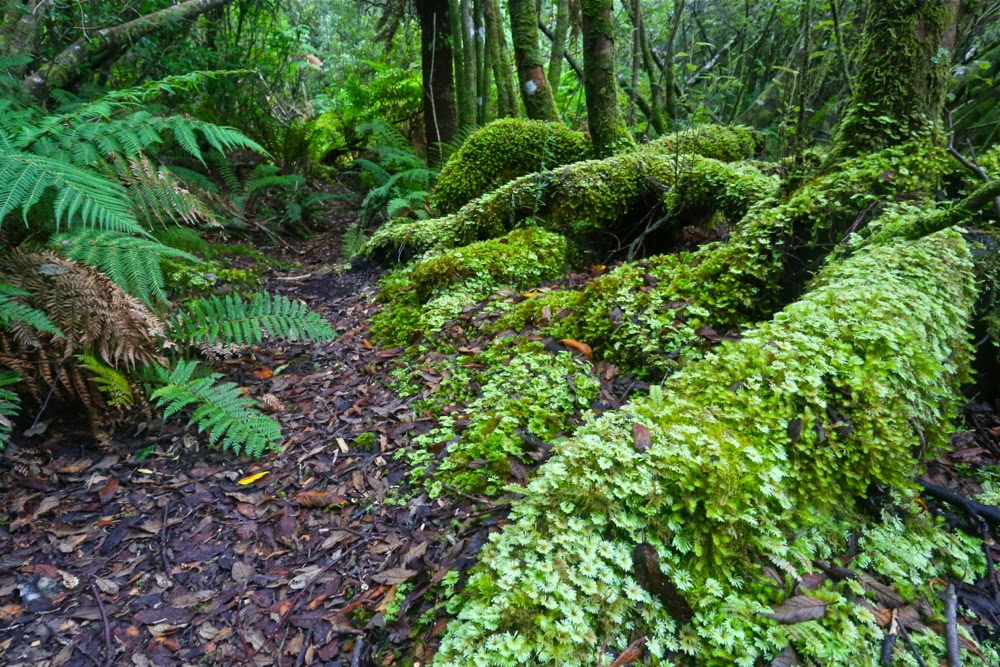
I hadn’t realised how very often we would be walking through glorious rainforest. When not walking along beaches, we were often in fairyland. Here is the forest behind Ketchem Bay where I went to play if I wanted a change from infinite beach.
This brings me to another issue that interested me this trip: the relativity of how we perceive experiences. It is always so hard to imagine that someone else might dislike what we love. I am still stunned that my neighbours actually hate trees. I don’t mean they don’t love them like I do. I mean they actually hate them. Here on this walk, we had a person who did not relish the experience in the way the rest of us did. The situation reminded me of CS Lewis’s busload of people from hell who go to visit heaven and hate it there, or William Blake’s phrase in his glorious poem about love (The Clod and the Pebble), how one can “build a Hell in Heaven’s despite” (and one can also “build a Heaven in Hell’s despair”).
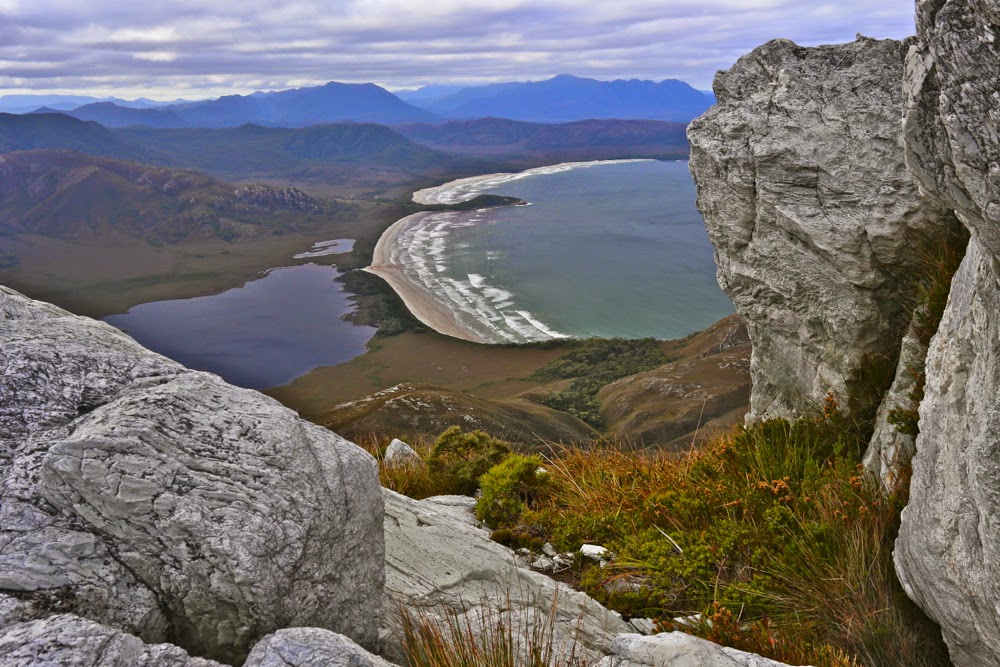
Day 5. The summit of New Harbour Range. For me, the equal highlight of our trip. I preferred its view to that of Mt Karamu, but enjoyed the utter remoteness of the latter. Each had so very much to offer.
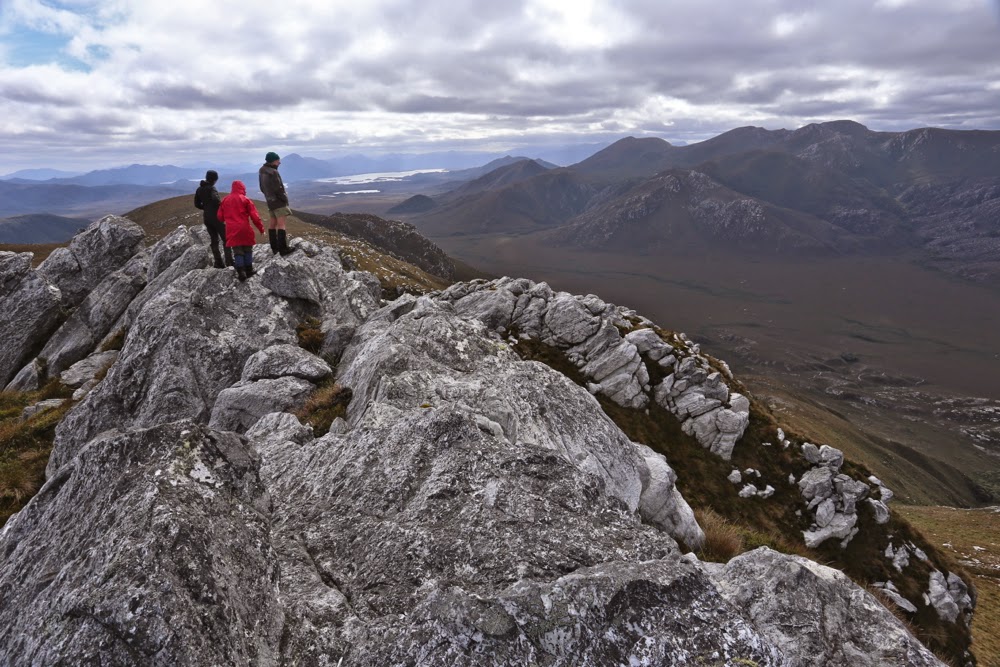
New Harbour Range summit, looking north to Melalauca, where the adventure began. We have nearly come full circle.
Tut. I have not described our route or what we did, other than gaze at beauty. The route is on the map – a little red line – or in Chapman’s guide. The mountains are mentioned and discussed in my photos above. What did we do other than gaze at wondrous beaches and climb heavenly mountains? We walked some more, pondered much, stared with wonder heaps, chatted, ate dehydrated food, sheltered in our tents from rain or sang glorious songs (well, I did) when the sun came out. We explored the minute detail of the superb wild beaches. I paced up and down, up and down said beaches. K collected bags of rubbish washed ashore by irresponsible and selfish boat people. C also paced the beaches, photographing little marine items that captured her attention. Mary sketched the most exquisite line drawing of Ketchem Island that quite literally took my breath away with its expertise, artistry and beauty; T did crosswords and trotted around the campsite in her new trendy shoes – two left crocs, way too big for her – that we salvaged from debris (she had regretted not brining camp shoes); V manufactured chairs out of other scraps of debris (perhaps her frypan chair was the most innovative), and served up gourmet food to her husband and J and V spent a great deal of time trying to dry their tent fly and sodden clothes on makeshift clotheslines.
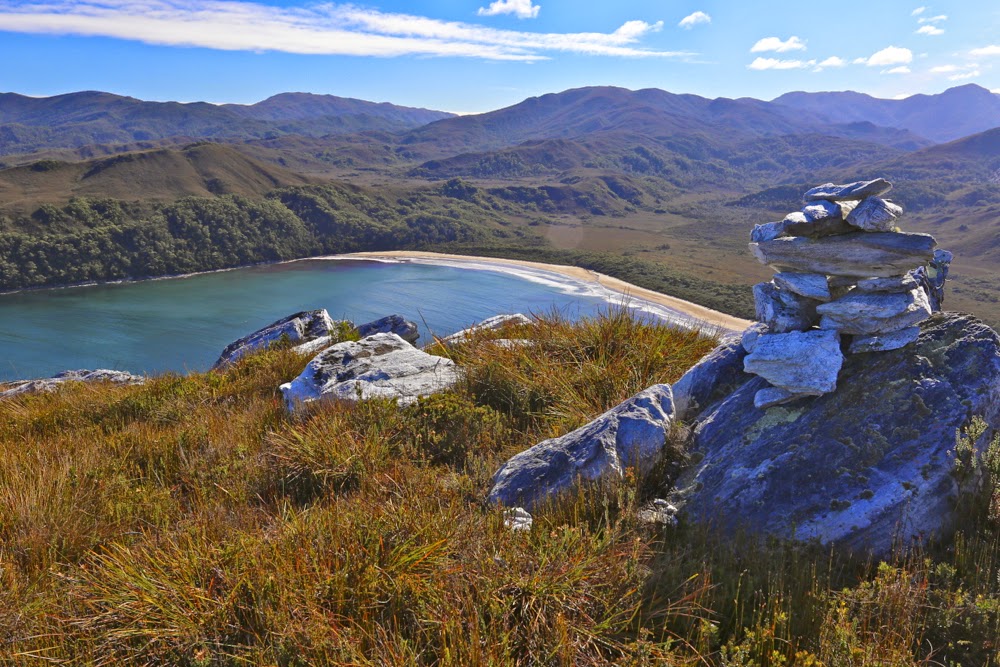
Looking back down to New Harbour from Smoke Signal Hill.
Back down at New Harbour.
“Do I want to return to civilisation?”, (odd word when one considers how very uncivilised most humans’ behaviour is, a point teased out superbly in David Malouf’s An Imaginary Life), the caretaker of Melaleuca asked me. “Yes”, I replied. There is a moment for everything. Wilderness is a glorious time out, but I also enjoy the rough and tumble of normal twentieth century life, and enjoy many of the luxuries it has to offer, like long, hot showers, lights to read by, chair backs to make reading comfortable, a fire in my hearth and real food and wine on my table, which nearly always has a candle burning at meal times and a flower from my garden to decorate it. If we keep technology as our slave rather than becoming enslaved to it, it has much to offer us, and I embrace many of those opportunities. Next week I’m off to Sydney to see Aida on the Harbour and the ballet, Giselle, at the Opera House. Many philosophers regard culture as the antithesis of nature. I love both.

My room with a view and all my worldly needs for six days.

